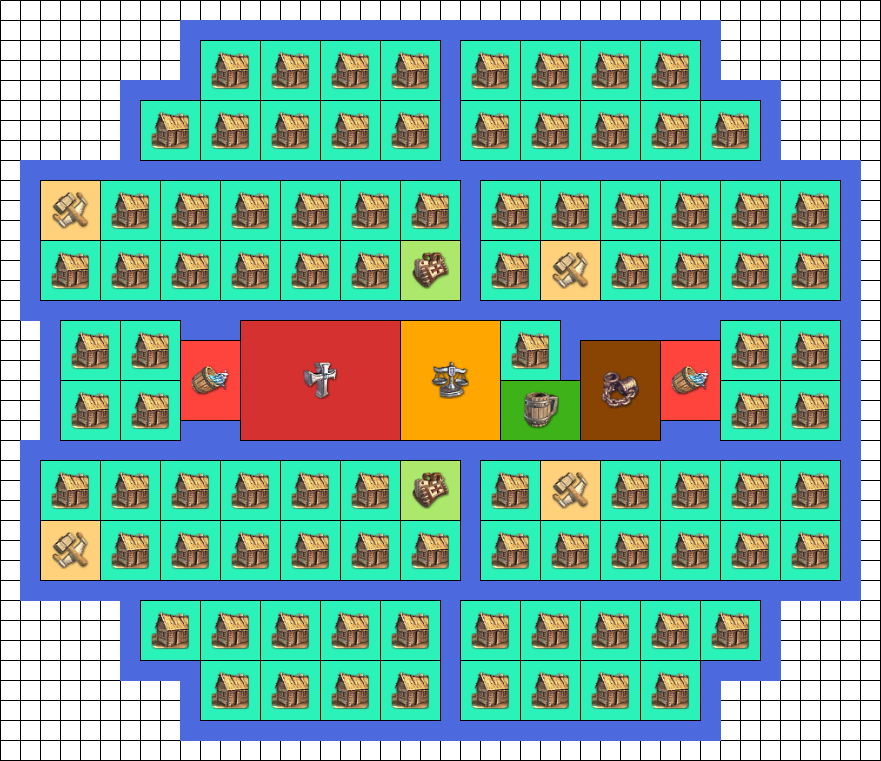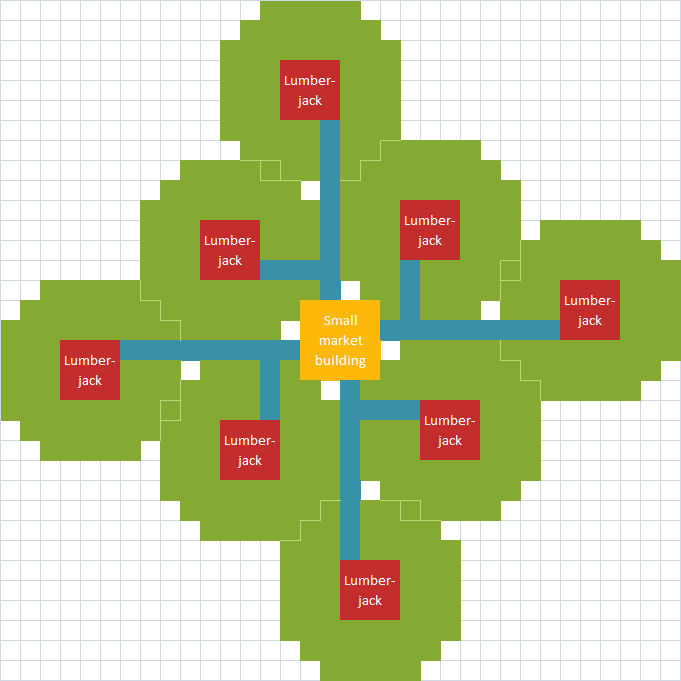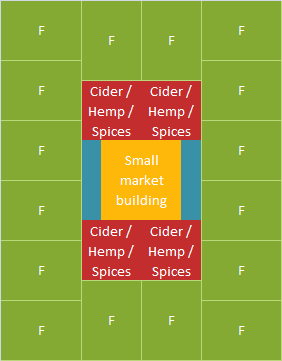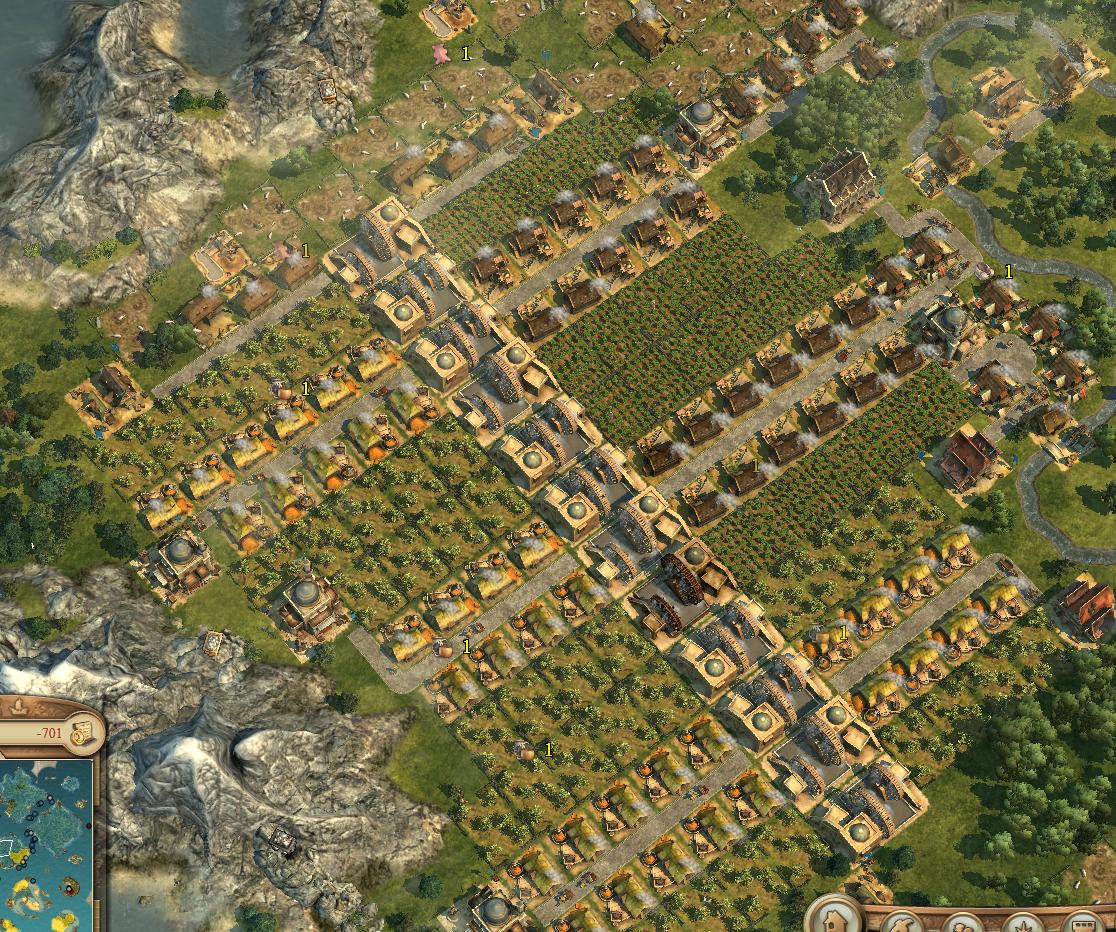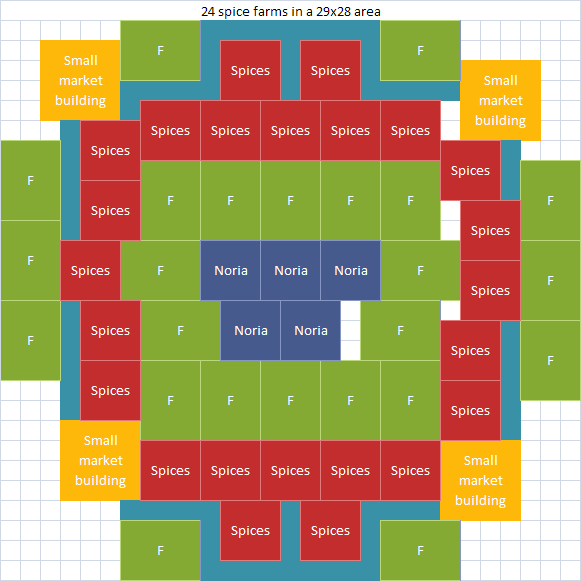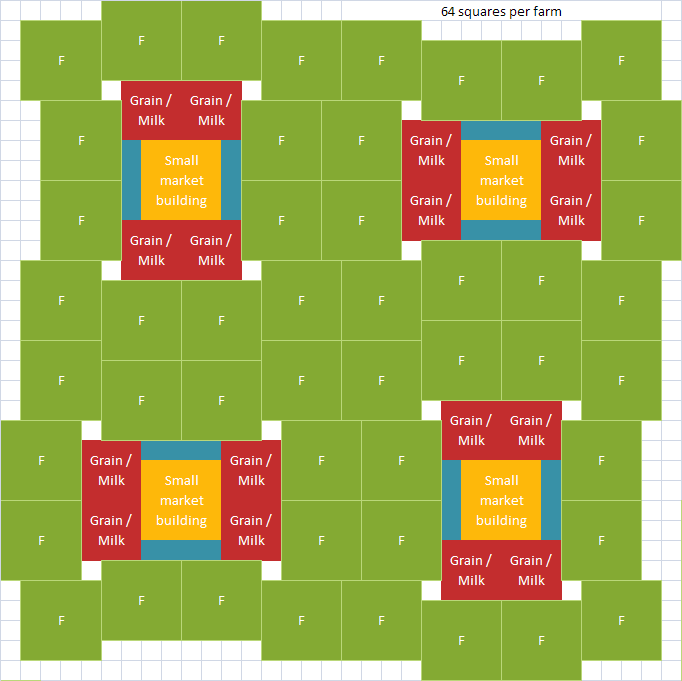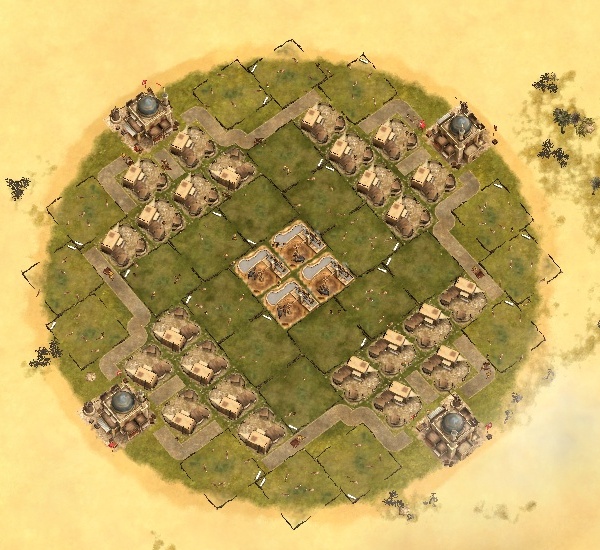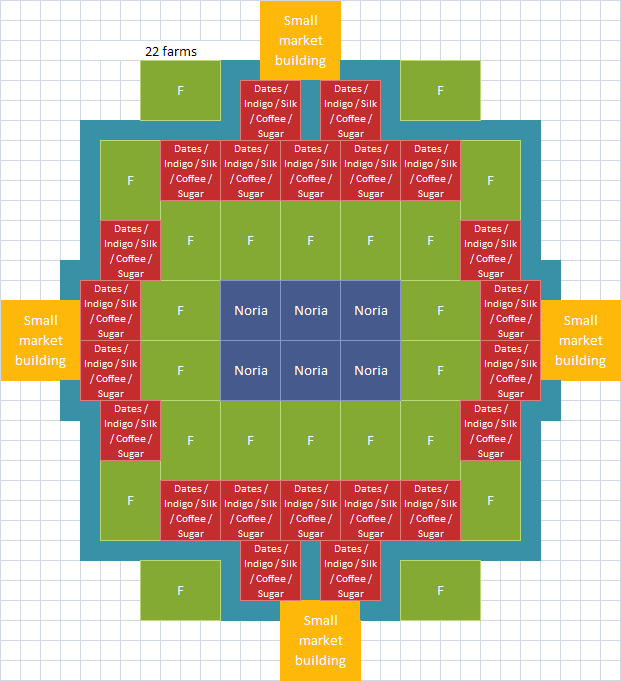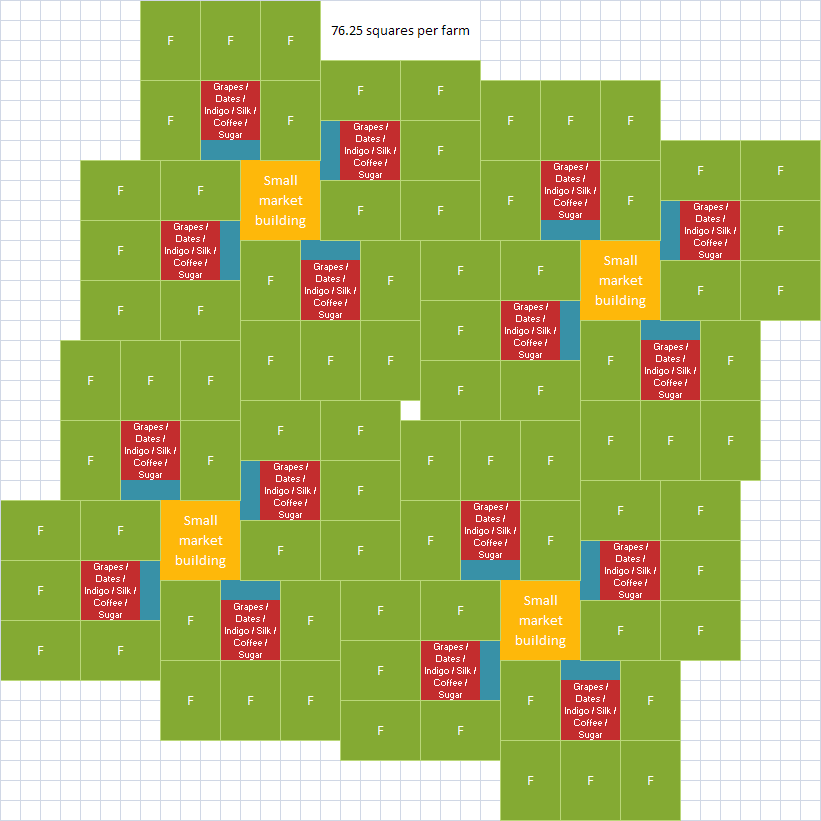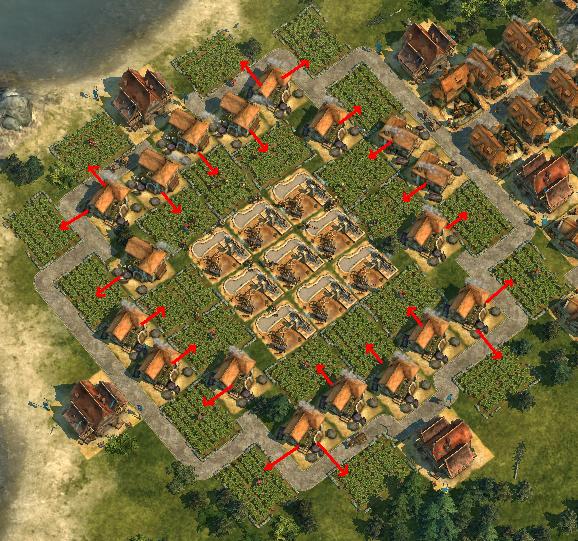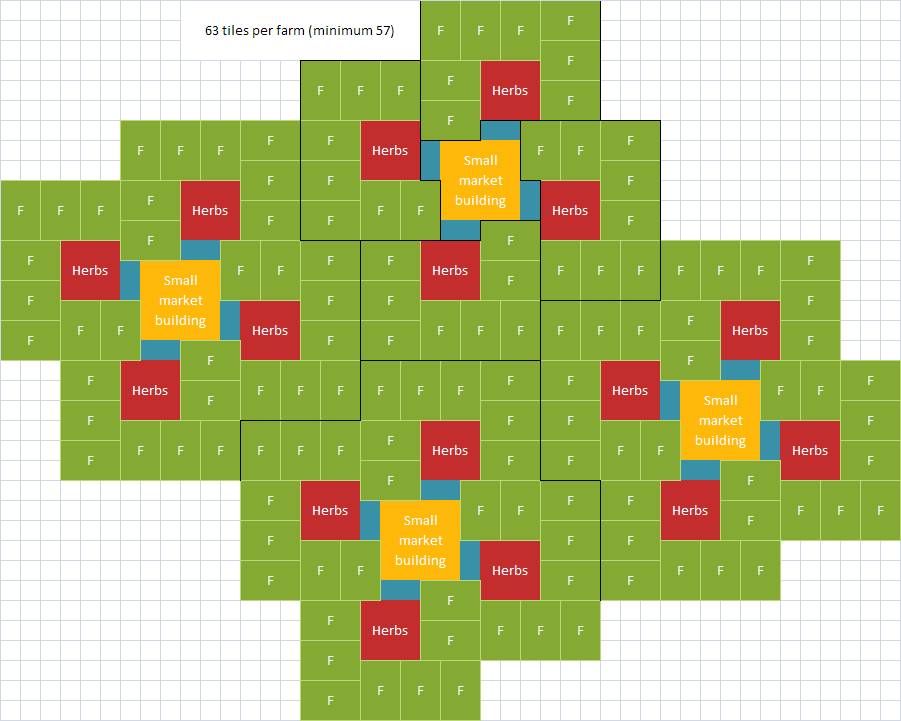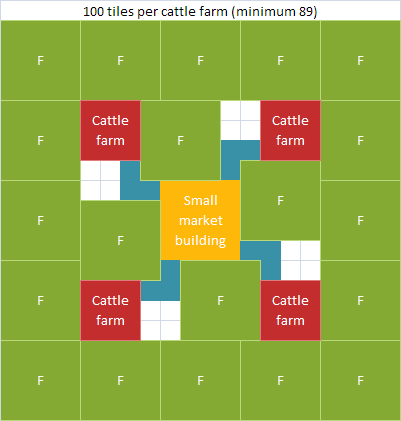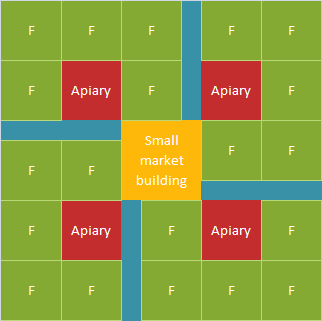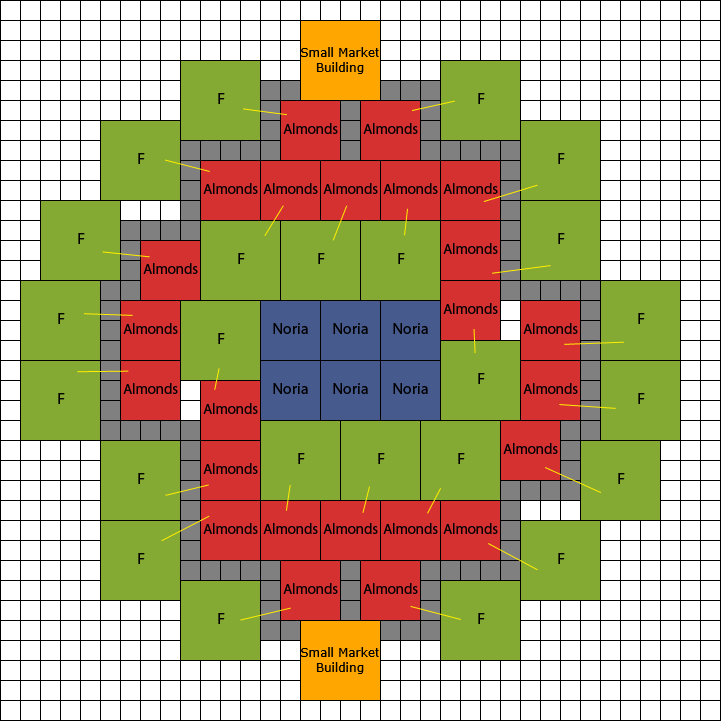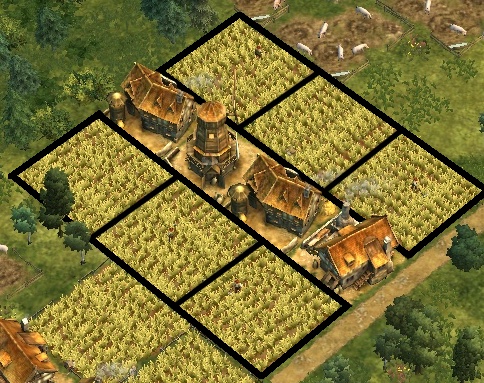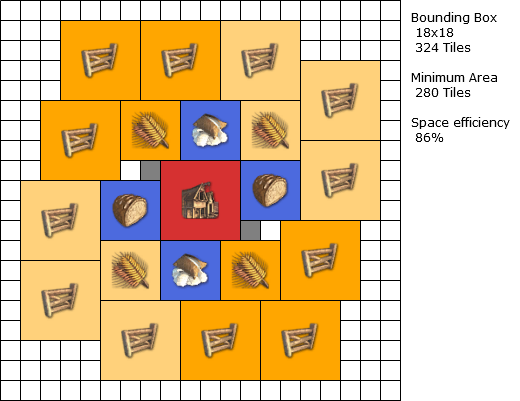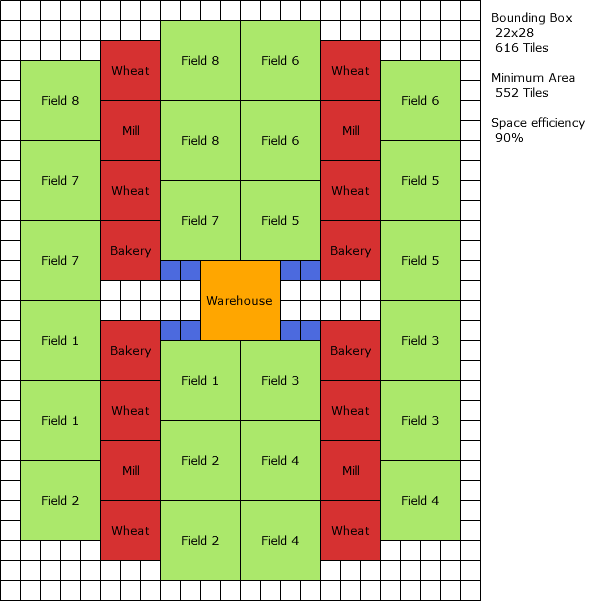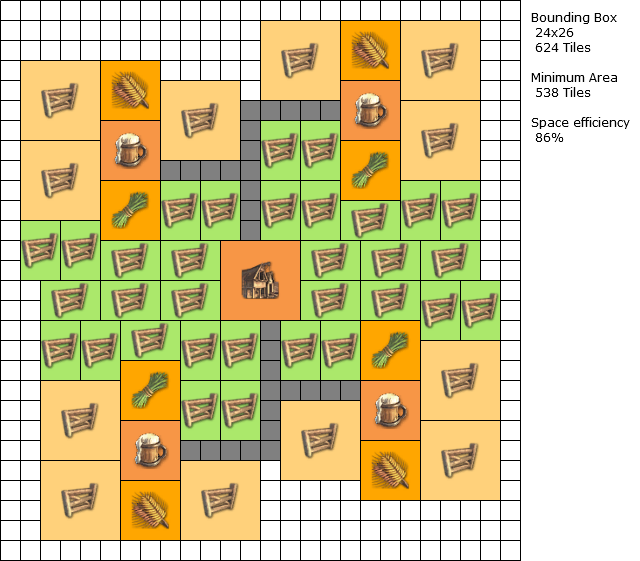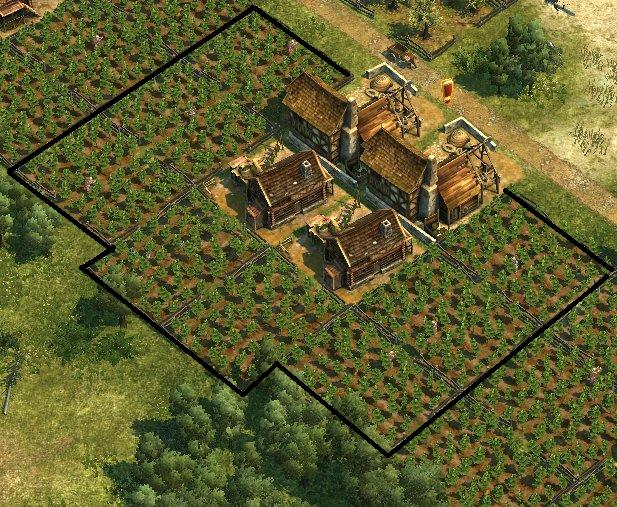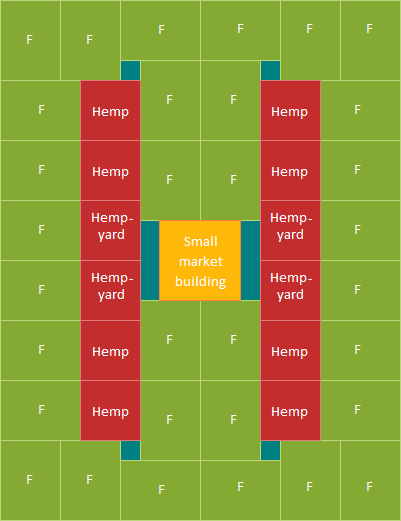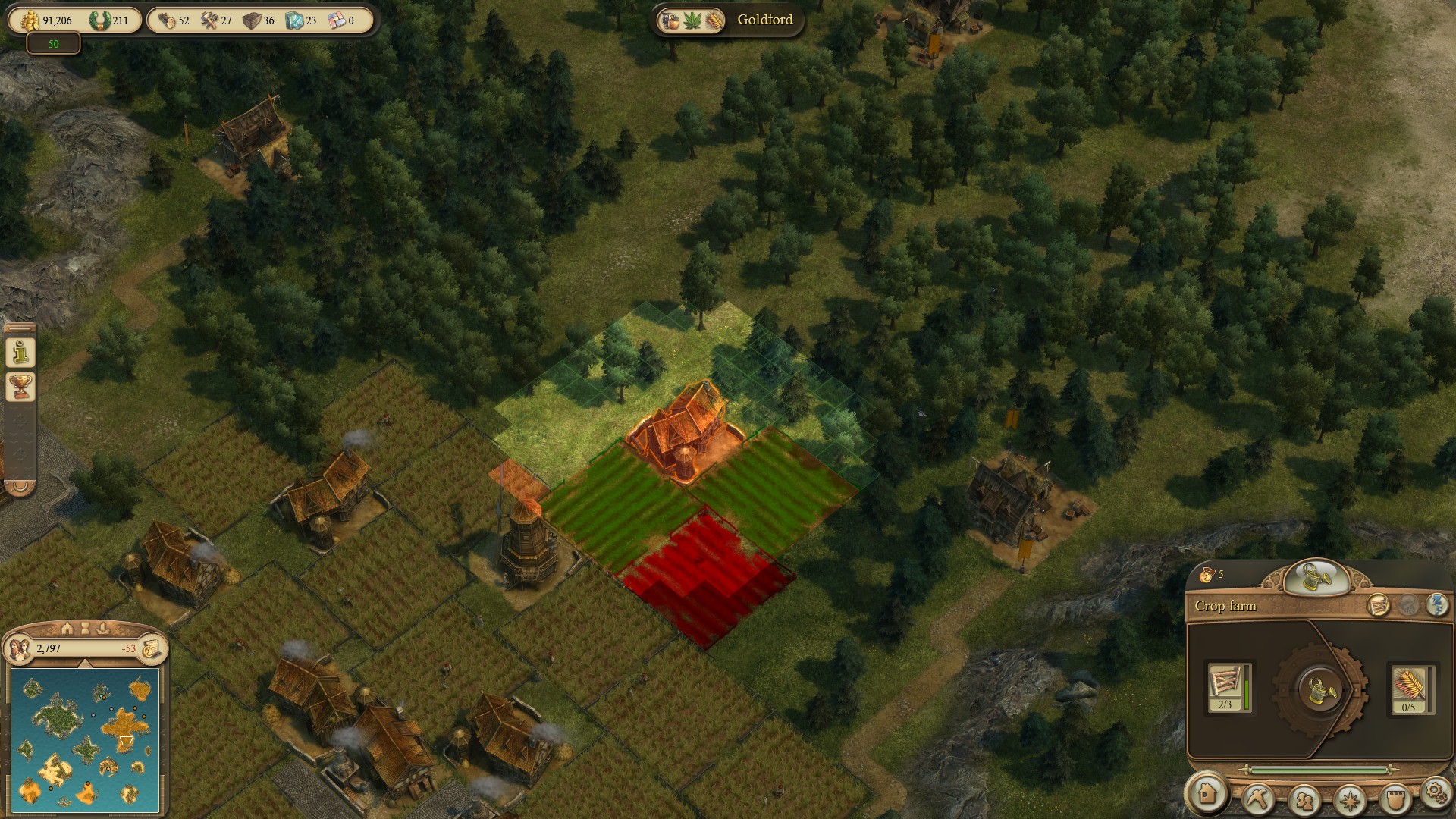Building layout strategies
This page gives examples of efficient layouts for houses and production facilities so the flow of goods is fast and space is conserved.
Contents
Housing [ edit | edit source ]
League of Ungentlemanly Warfare’s Occidental Layout [ edit | edit source ]
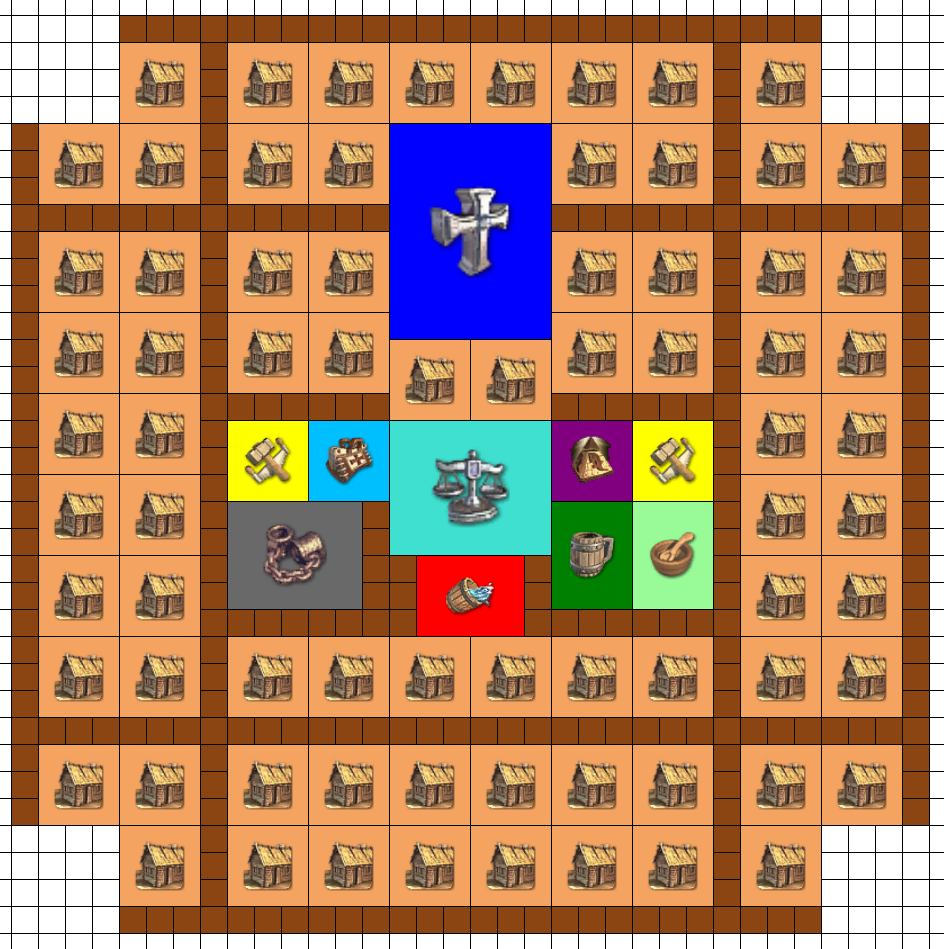
Additionally, if not playing with Fires, Disease, Wear, or Spies; the Carpenter’s Hut, Surgeon, Base of operations, and Fire House can all be replaced with standard houses. The Alms house can also be changed to housing if not required.


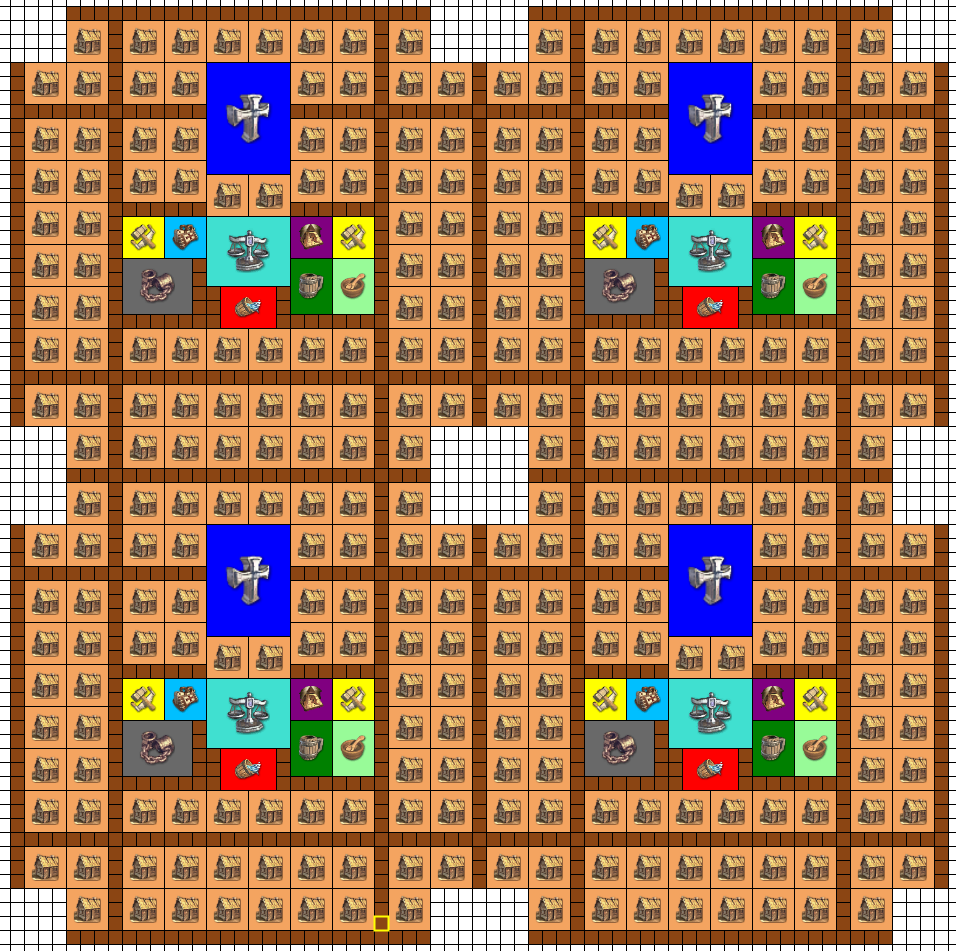
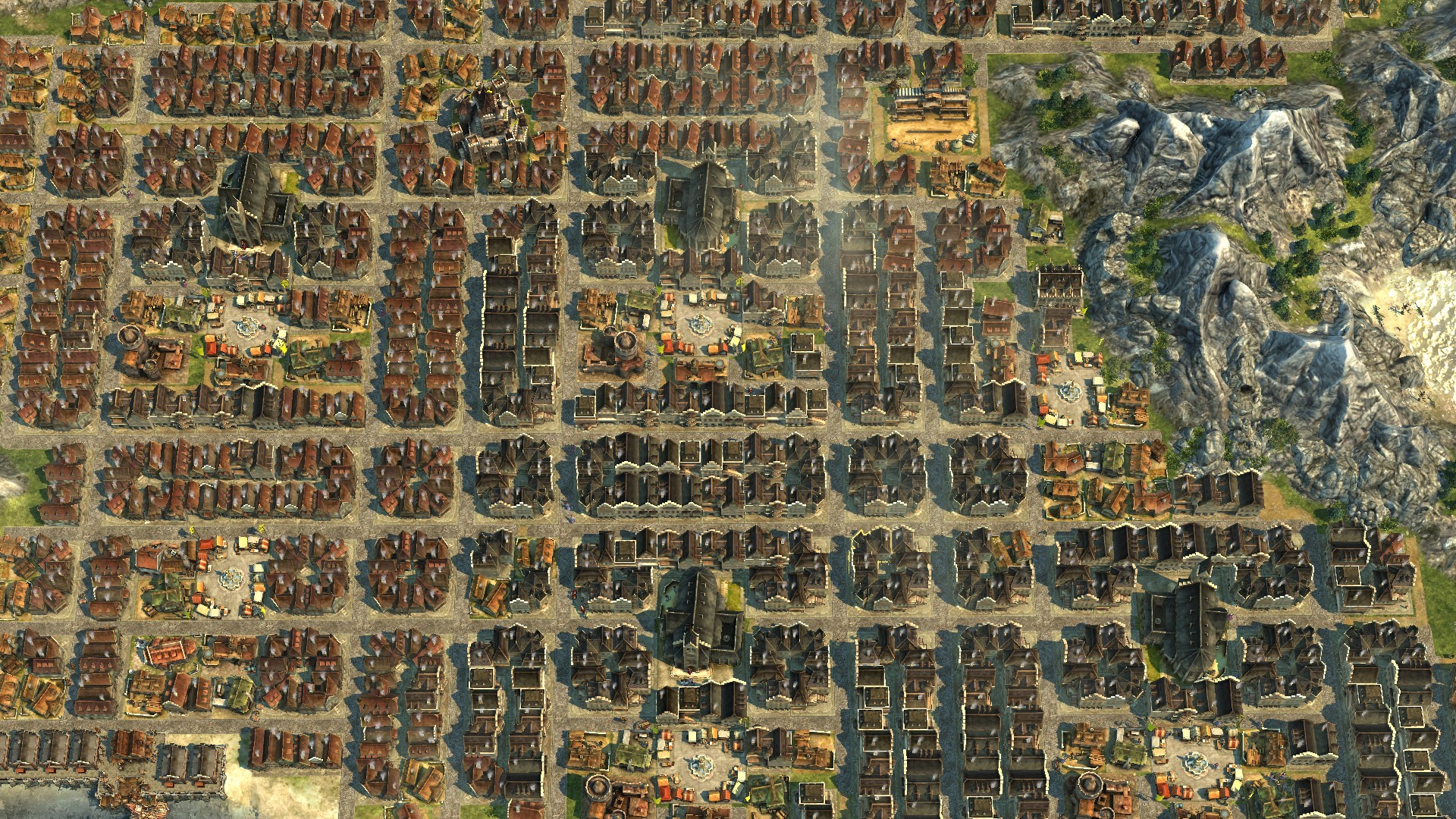
Large scale occidental layout [ edit | edit source ]
Big City building plan

Building plan with calamity buildings
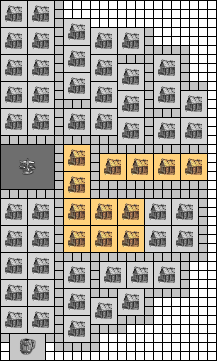
Preparing for «Need-Buildings»
The first image shows the outcome, if you are playing without the need for Carpenters, Fire Stations and Surgeries.
The second image shows where to place calamity buildings (Carpenters, Fire Stations and Surgeries) if you set up game for them. This will «cost» you 9 Houses per Market Building.
The third image shows how to prepare for the «Need Buildings»: Build the houses in this way, so (later on) to easily make place for the Tavern, Church and Prison.
In the first image the center is left open. This is best filled with a Market Building. An additional Market Place can be build here, but houses built around it will be out of the influence areas of the «Need Buildings». You could make a beautiful garden here, as well.
4 Market Place ·
340 Houses ·
16 Chapels ·
4 Church ·
12 Taverns ·
4 Prisons
Small versatile occidental layout [ edit | edit source ]
Layout with patricians

Layout with noblemen

Nearly every house has access to all the service-buildings. Only the left-most column doesn’t have access to the tavern and the middle-two houses next to the marketplace aren’t protected by the Spy houses.
The colors represent the ratios of promotions (grey = peasant, green = citizen, red = patrician, pink = nobleman).
Alms house can easily be added above the left-most fire station by replacing the house and the three roads above.
Chapels can be built on the location of the Church and the Prison.
Layout can be scaled in all directions.
1 Marketplace · 100 houses · 1 church · 3 carpenter’s house · 2 fire stations · 4 bases of operation · 1 tavern · 1 debtor’s prison · (2 surgeries) · 4 small market buildings
Small scale occidental layout [ edit | edit source ]

For protection against sickness and plague and fire, additional houses must be demolished to make space for such facilities.
1 Marketplace · 87 houses · 4 chapels · 4 carpenter’s house · 2 taverns · 1 debtor’s prison · 1 church
Occidental layout I [ edit | edit source ]
Second Image shows where to put Fire Stations, if you want them. Doesn’t support the 3 Houses at top or bottom.
1 Marketplace · 101 Houses · 1 Church · 1 Tavern · 1 Debtor’s prison · 4 Carpenter’s houses · 2 Surgeries · 1 Small market building
Occidental layout II [ edit | edit source ]
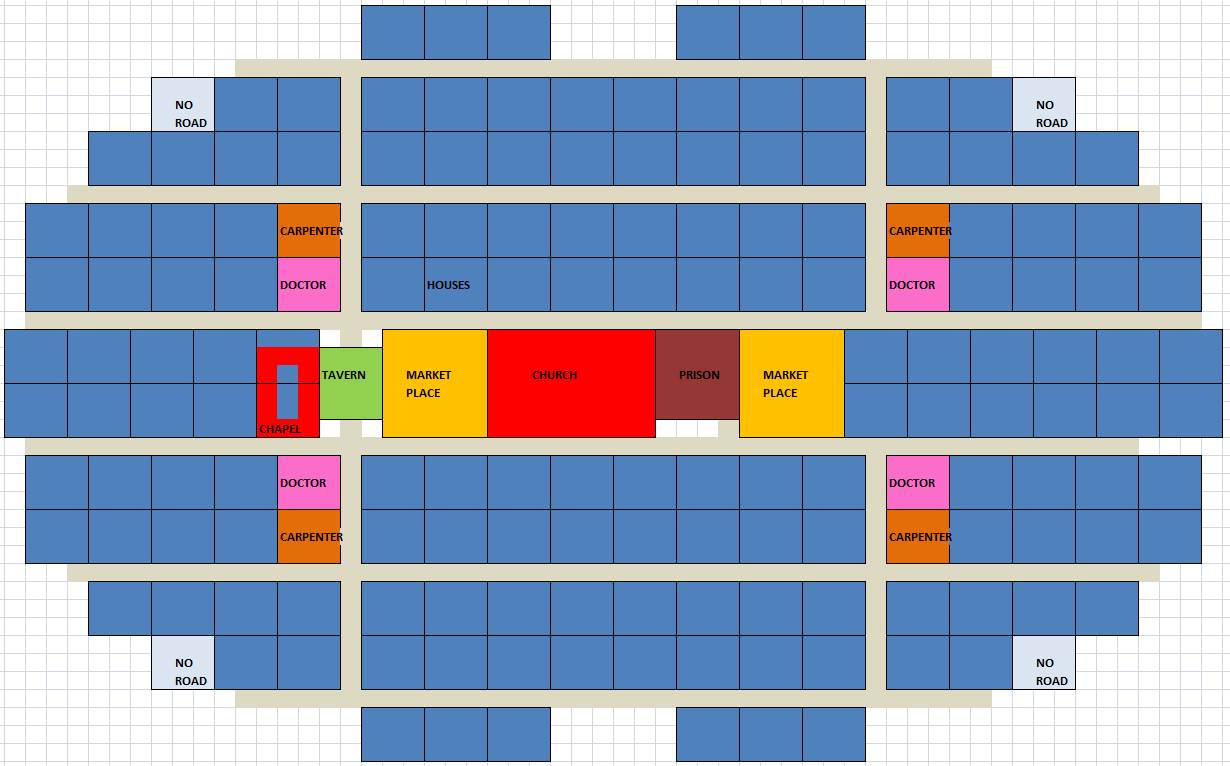
Alms houses can be built instead of a house at the edge of the city.
- Possible to build step by step
- The doctors and carpenters are placed near the crossroads
- The doctors and carpenters can’t reach the other side of the city so they serve a smaller area but at a higher efficiency
- Long straight roads are easy for person finding quests
- Easy to fit between mountains and rivers on all large islands
- Minimum of public buildings
- Without an extra market building or place 4 houses in the corners can have no road connection
2 Marketplaces · 152 + 4 Houses · 1 Chapel · 1 Tavern · 4 Carpenter’s house · 4 Surgeries · 1 Debtor’s prison · 1 Church ·
Oriental layout [ edit | edit source ]
1 Bazaar · 108 Houses · 1 Mosque · 1 Bath house
Imperial Cathedral with houses I [ edit | edit source ]
Imperial Cathedral with 334 houses
1 Imperial Cathedral · 334 houses
Imperial Cathedral with houses II [ edit | edit source ]
Imperial Cathedral with 342 houses, and a straight design.

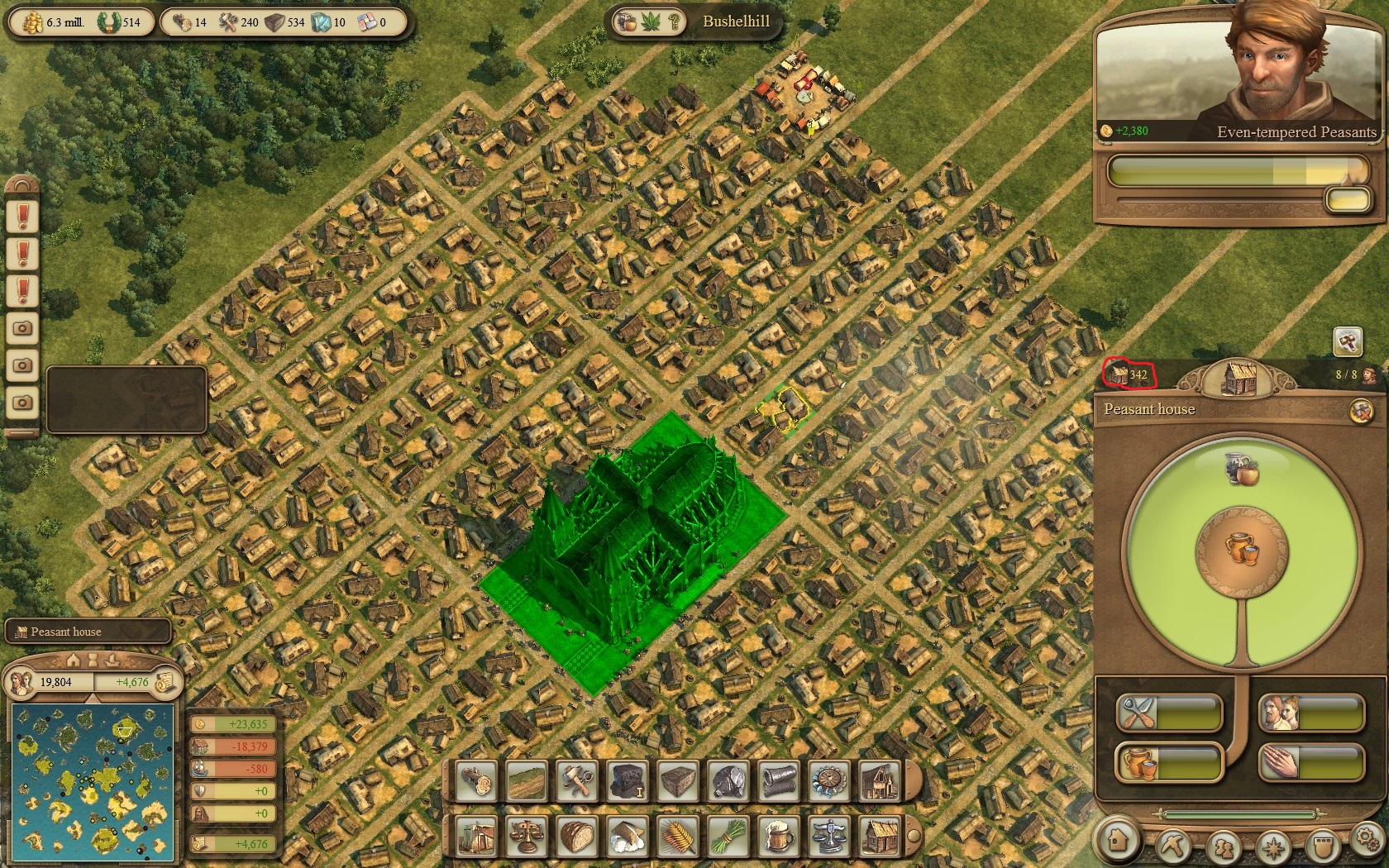
Ctrl and scroll to zoom

1 Imperial Cathedral · 342 houses
Imperial Cathedral with houses III [ edit | edit source ]
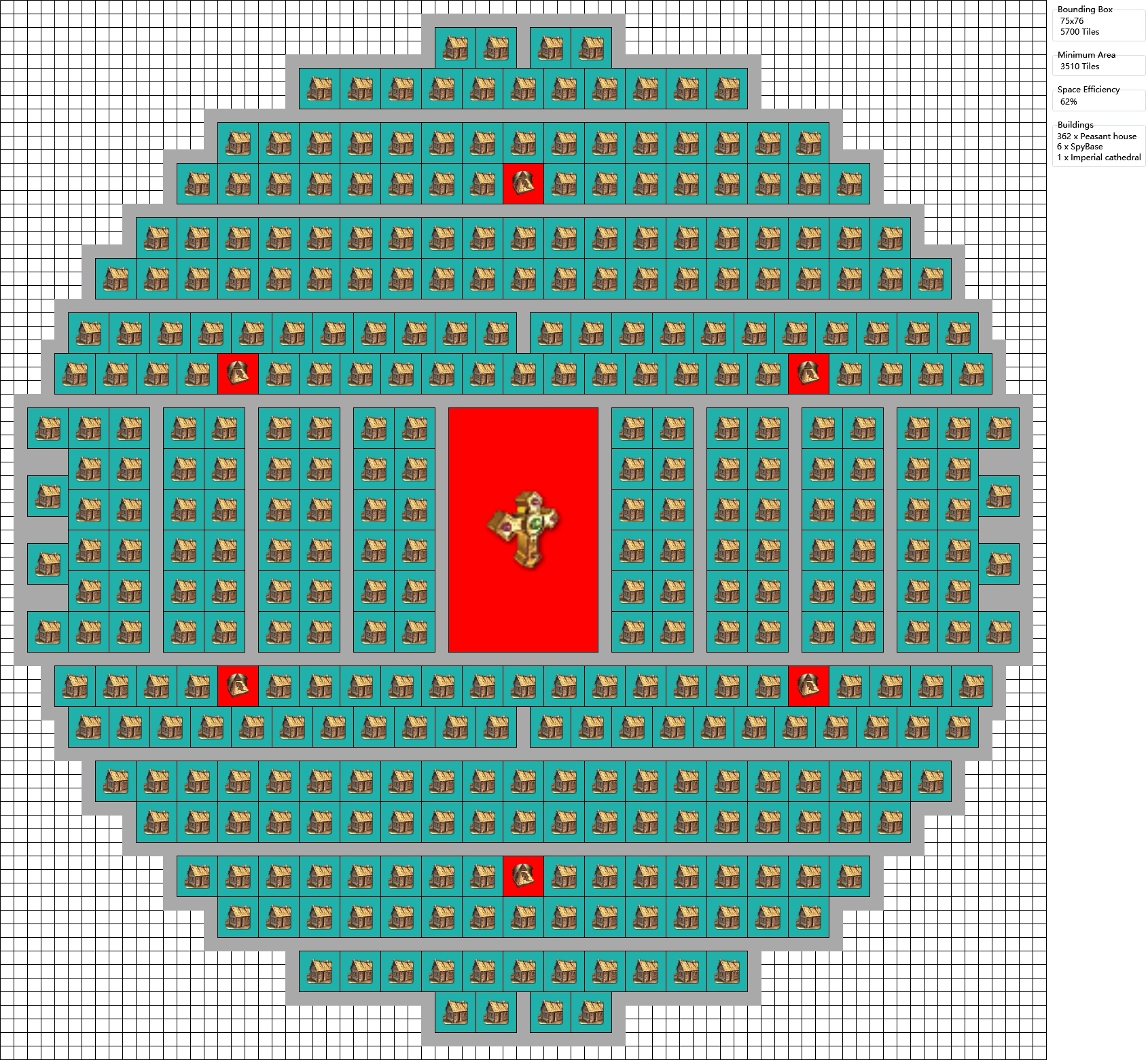
In this picture 6 houses are replaced with Base of Operations. These 6 can cover the whole area.
Sultan’s Mosque with houses [ edit | edit source ]
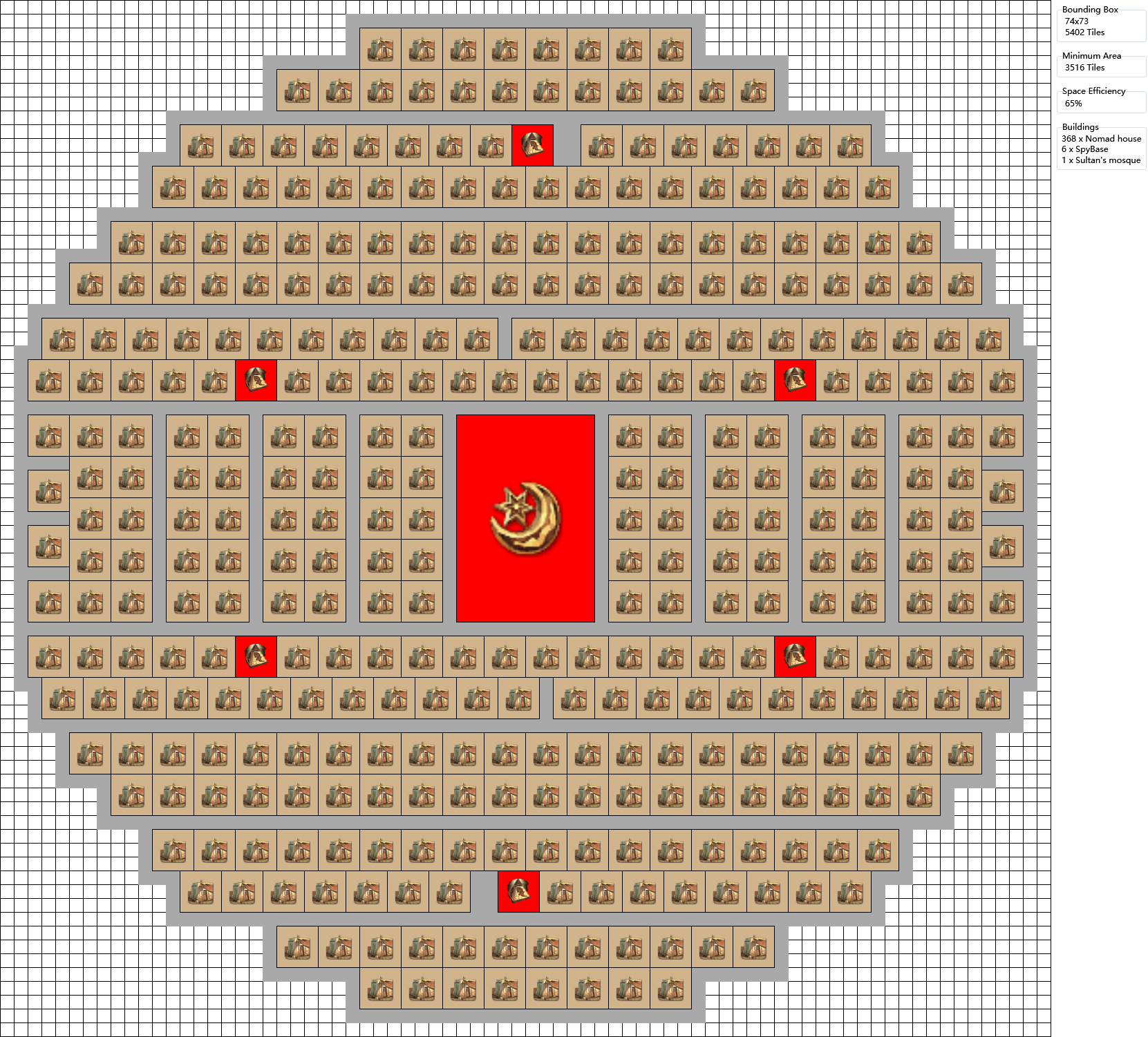
In this picture 6 houses are replaced with Base of Operations. These 6 can cover the whole area.
Imperial Cathedral with houses and protection buildings [ edit | edit source ]
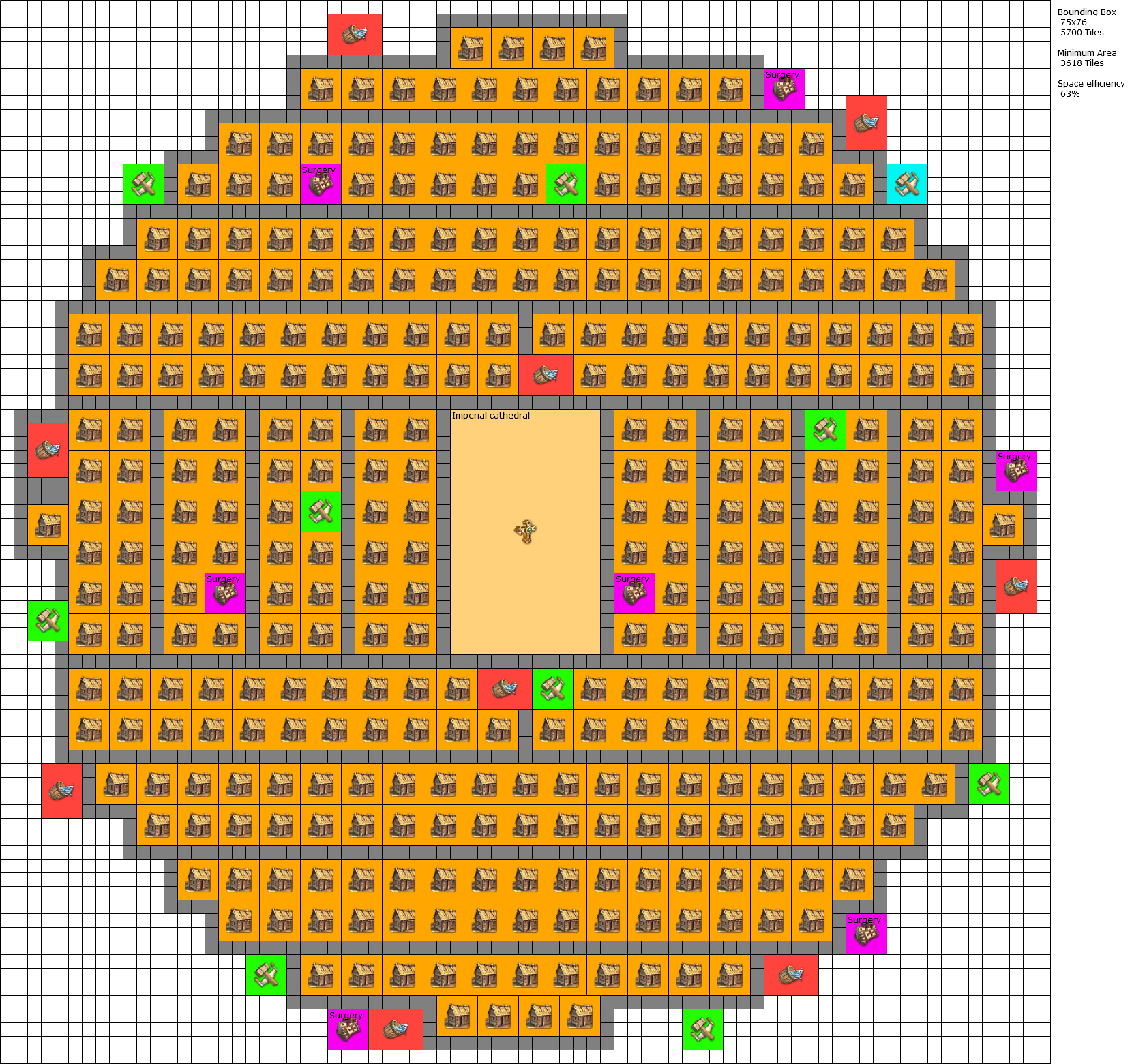
The cyan carpenter has only three houses in his area, so you can just place it on a per-need basis.
Also the roads are quite long, so to garantuee fast help, build stone streets or similar.
1 Imperial Cathedral
One Market Place — 100 houses [ edit | edit source ]
1 Market Place, how many houses does it fit?
1 Market Place · 100 Houses, or · 96 Houses · 4 Chapels
Single production steps [ edit | edit source ]
Even though farms usually do not need a road connection (the next building in the production chain can collect the goods directly), there are advantages to providing road connections.
- Allows stockpiling of intermediate goods. Useful as additional buffer or to complete quests with. Examples:
- On an Occidental island, your silk and indigo can be wired directly to a carpet factory. If the silk and indigo are not running at the same percent productivity, the more productive one will waste product.
- If you need iron ore for a quest and you’ve wired ore directly into a smelter, you can’t simply turn off the smelter and have iron ore show up in your warehouse. (Of course, you might be able to make a path and/or rebuild something in the way, later.)
- Allows separating of farms and production buildings. This prevents production building staff to take long walks for small amounts of goods. Production buildings with a large collection range and high throughput (e.g. mill, bakery) can spend so much time visiting other buildings that they don’t operate on full capacity.
| The placement of 4 production buildings, with 1 Market Building. The size of the farms are 3×4. | |||||||||||||||||||||||||||
| The placement of 5 production buildings, with 1 Market Building. The size of the farms are 3×4. There is even room for 2 additional farms. This does not make production go faster, or make efficiency go up, but looks nicely full. | |||||||||||||||||||||||||||
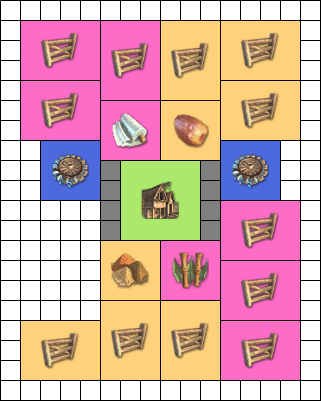  | Uses Noria exploit. The placement of 5 production buildings, with 1 Market Building. The size of the farms are 3×4. To increase efficiency, add more Market Buildings with (almost) the same layout (second image).Every Market Building needs a 7+4+7 height and 5+4+5 width (18×14 in total) | ||||||||||||||||||||||||||
| The placement of 6 production buildings, with 1 Market Building. The size of the farms are 3×4. Two buildings (from one diagonal line) have only 5 fields. But in total this base model is easily copied. | |||||||||||||||||||||||||||
| The placement of 8 production buildings, with 1 Market Building. The size of the farms are 2×3. | |||||||||||||||||||||||||||
| All huts run at 100%, although you may have to press the Cultivate button after building the roads to get them back up to 100% (Note that it is significantly cheaper to manually build any required trees at 5 gold per tree, each tree gives 3% productivity). There is one tile of overlap between each pair of huts. The small market building can almost completely keep up with production when using dirt roads, and keeps up without trouble if you upgrade to stone roads.
|
| All huts can run at 100%. The roads outside are to show the boundary of this layout. You will need to manually plant trees or even remove existing trees if they are too large. Best if you remove all existing trees first before manually planting all trees. | |||||||||||||||||||||||||
| All huts run at 100% (see noria exploit), remember to press the Cultivate button after building the roads. | |||||||||||||||||||||||||||
| Cider / Hemp / Spices
Uses 63 tiles per farm. If you use this for spices and don’t have (enough) irrigated land, you can either place norias beside the blocks or replace two fields (of different farms) with small norias and use the noria exploit.
| You can place lots of farms at both sides of the large norias column. All plantations runs at 100% (see noria exploit). | ||||||||||||||||||||||||||
|---|---|---|---|---|---|---|---|---|---|---|---|---|---|---|---|---|---|---|---|---|---|---|---|---|---|---|---|
| Cider / Hemp
| 16 Hemp/Cider farms, all fields within the market radius. | ||||||||||||||||||||||||||
| (Almost) all Oriental Farms
You can build farms up to 5 fields. If the farm doesn’t need a road, you don’t need to build the road (red). In the middle you can build a market building with a small noria, a market building with a process building or 2 process buildings. The choice is yours. If you build a spice farm you can leave 1 field (yellow) and build a large noria, market building, or process building instead. Large Norias can also be set at the edge.
| A layout for 24 spice farms around 5 norias. All farms run at 100% (see noria exploit). Fits in a 29×28 area. | ||||||||||||||||||||||||||
Wheat / Milk   | Wheat/Milk farm layout Uses 64 tiles per farm. Four blocks are displayed, showing how multiple blocks can be combined without wasting space in between. Note that since goat farms don’t require any fertilities, you can build them on northern islands. If you’re building goat farms on infertile land, you can either place noria’s beside the blocks, or replace some fields (of different farms) with norias and use the noria exploit. | ||||||||||||||||||||||||||
Wheat / Milk   |  | 92% Efficiency, 6 fields. 28×12 | |||||||||||||||||||||||||
| Wheat / Milk / Cattle farms
Uses 37 tiles per farm. For wheat adequate fertility is also necessary. Keep in mind that wheat cannot grow on southern islands, and that all these facilities can be built on northern islands. This setup should only be used when you have no more building space left! Otherwise it would be a waste of money, because a noria exploit costs more money in maintenance than a regular farm.
24 milk plantations on 4 norias Grid Layout of the previous image Only usable on southern islands with use of noria exploit. 24 goat milk farms with 4 norias run on 100% efficiency. Be aware that each milk ton produced does drain water from every noria which will noticeably up the cost of milk (due to its low value). Dates / Indigo / Silk / Coffee / Sugar
Date/Indigo/Silk/Coffee/Sugar farms with noria exploit A layout for 22 Date / Indigo / Silk / Coffee / Sugar farms around 6 norias. All farms run at 100% efficiency (see noria exploit). This layout is not suitable for grapes. [2] | |||||||||||||||||||||||||||
| Dates / Indigo / Silk / Coffee / Sugar
Rectangular Layout for Noria Exploit | This is a similar layout to the one above, I just moved the market buildings to the corners to create a rectangular layout. | ||||||||||||||||||||||||||
| Grapes / Dates / Indigo / Silk / Coffee / Sugar
Grapes/Dates/Indigo/Silk/Coffee/Sugar farm layout This layout is usable for grape, date, indigo, silk, coffee and sugar plantations on green soil. Uses 76.25 tiles per farm. Four blocks are displayed, showing how to combine multiple blocks while wasting only one tile per block. Dates / Indigo / Silk / Coffee / Sugar
This layout is usable for date, indigo, silk, coffee and sugar plantations on dry soil including norias. The warehouses on the end of the layout can be used for quarries or other production facilities. On strictly dry soil the farms produce at a reduced rate (91%). Uses 82.25 tiles per farm, where 69 is theoretical minimum. Does not use the noria exploit. Four blocks are displayed, showing how to combine multiple blocks while wasting only 3 tiles between «columns».
| A layout for 18 grape plantations around 9 norias (usable for northern islands). All farms run at 100% (see noria exploit). | ||||||||||||||||||||||||||
| Monastery gardens (for beer)  | | Herb farms are very flexible in their placement due to their small fields, so you will typically cram these into otherwise unused corners of your island. However, if you have large amounts of open space and want to use it efficiently, you can use this layout. Uses 63 tiles per herb farm, where 57 tiles is the absolute minimum. Four blocks are displayed, showing how multiple blocks can be combined without wasting space in between.
4 Herbs farm layout | This is an alternative to the layout shown above. This uses up the same amount of space as the one above, but, as you can see, the layout resembles in a square, allowing you to be more flexible when combining multiple of these layouts. Ultimately, the shape of your «beer island» would probably determine which of these 2 layouts you would prefer. Note that 3 fields are slightly off the monastery radius, but the efficiency is still 100% and you do not need to rebuild the monastery to build the fields. Three blocks are displayed, showing how multiple blocks can be combined with minimal wasted space in between. Animal hides
Upper layout uses 67.5 tiles per farm where 73 tiles is the absolute minimum without noria exploit. The lower layout uses 60 tiles per farm, but you have to use the field exploit (see below) which will result in higher building costs. Both layouts work on southern and northern islands. Pig farms run at 100% with 3 norias or 2 norias on dry soil. They will run at 95% with 2 norias on fertile soil. Cattle farms run at 100% with 3 norias. There is also space to for other buildings, e.g. process plants. Cattle farms
Layout for cattle farms Uses 100 tiles per cattle farm, where 89 tiles is the absolute minimum. Cattle farms need five 4×4 fields; pig farms only need four 4×4 fields. Layout for processing plants | Although you can usually place processing plants such as Weaver’s Huts and Wine Presses near your warehouse — it has spare market carts anyway — sometimes this does not work well. For example, once your city grows large, you need so much bread that you cannot place all of your mills and bakeries next to a single warehouse and have them all close enough to work at maximum capacity. In this case, the layout shown here is a good alternative. Works for any processing buildings. Note: keep bakeries and mills well separated if you have many; otherwise they will be tempted to pick up goods directly and waste time taking long walks. | This layout is usable for apiaries (64 tiles per apiary). Is square, so scales easily and without wasting space between blocks. The extended road deadspaces allow some «give» on the corners of the layout. If you barely can’t fit a tight corner (15 tiles, not 16), you can push in a set of beehives along an edge. And since it’s symmetrical, you can do a «mirror image», if needed. The extended road spaces can also let you place factories or whatever at the edge of the configuration, although you may need stone roads or to enlarge the market building so it can keep up. | ||||||||||||||||||||||
| Rose nurseries (for perfume)  | 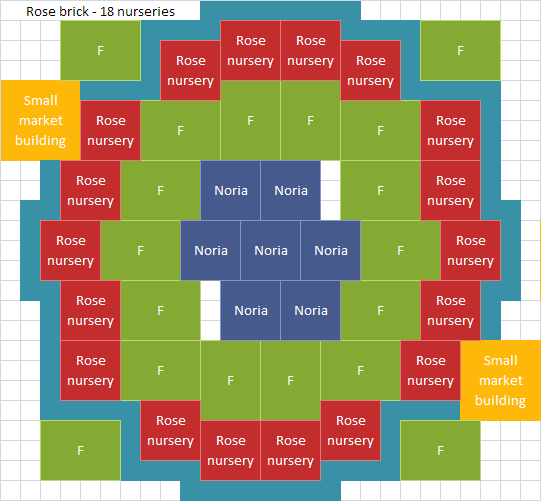 Rose nurseries with noria exploit | Uses noria exploit. A block of 18 rose nurseries supplied by 7 small norias. All nurseries operate at 100% (see noria exploit). You can place perfumeries along the road if you like. | |||||||||||||||||||||||||
| Rose nurseries (for perfume)  | 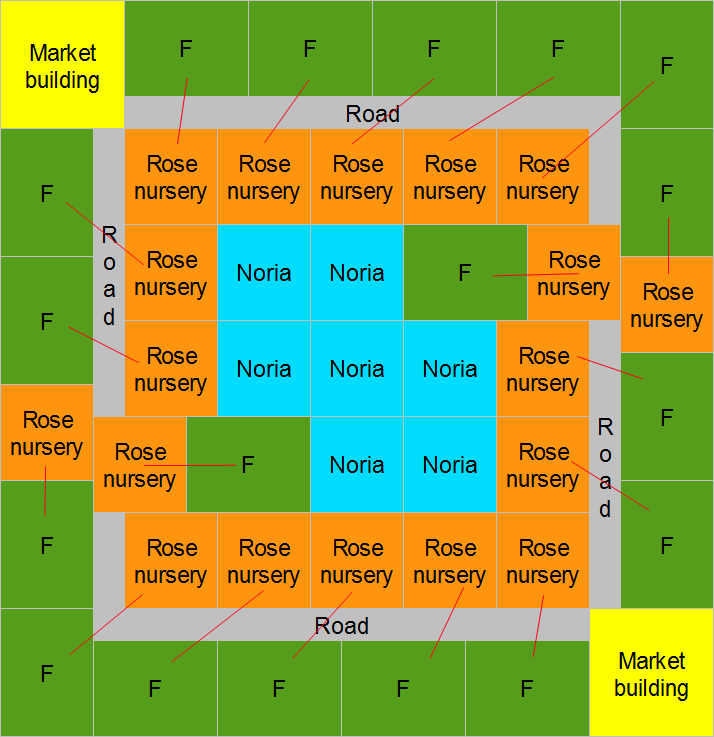 Rose nurseries with noria exploit | Uses noria exploit. A perfect 23×23 square of 18 rose nurseries supplied by 7 small norias and 2 market buildings. All nurseries operate at 100% on dry soil (see noria exploit). This layout uses 29.38 tiles per farm where 21 is the absolute minimum with noria exploit and 81 without. Rose nurseries
Rose nursery layout This layout is usable for rose nurseries on fertile soil, or with norias added around it. Uses 90 tiles per nursery, where 81 tiles is the absolute minimum without using the noria exploit. This alternative layout allows 1 marketplace to supply 6 rose nurseries in a perfect 18×30 rectangle. May require market building upgrade. Does not include norias so suitable for fertile soil or with norias added around it.
This layout is used for almonds on fertile soil or with norias around it. Uses 100 tiles per almond plant, where 89 is the minimum without the noria exploit.
Grid Layout of the previous image These are 24 almond farms supplied by 6 small norias. All farms operate at 100% (see noria exploit). Grapes 20 Single-field grape plantations at 100% This scaleable layout used for 20 single-field grape plantations around 9 norias uses only 2 market buildings. All fields run at 100% capacity using the noria exploit. Uses 30.45 tiles per plantation where 21 is the minimum. 8 Oriental Farm Structure | A simple configuration that balances space and economy. All 5 field farms run at 100% on dry soil. Pictured are 8 farms for the production of carpets which supply 4 carpet workshops. Also works for 8 Date plantations, Sugar farms or Coffee plantations. Can be modified for 6 Rose farms running at 100% using 4 fields per farm with 2 integrated Perfumeries. Can also be used for Spice farms however only 1 field per farm is saved making it less space efficient. Can be modified for 10 Spice farms running at 95% (9.5 farm equivalent) with 2 fields each. Uses noria exploit but is highly economical as only 2 Norias are used. | ||||||||||||||||||||||||
| Cider and Hemp with Noria Exploit |  | 18 Hemp or Cider farms all working at 100%. Uses noria exploit. | |||||||||||||||||||||||||
| Cider and Hemp with Noria Exploit
| 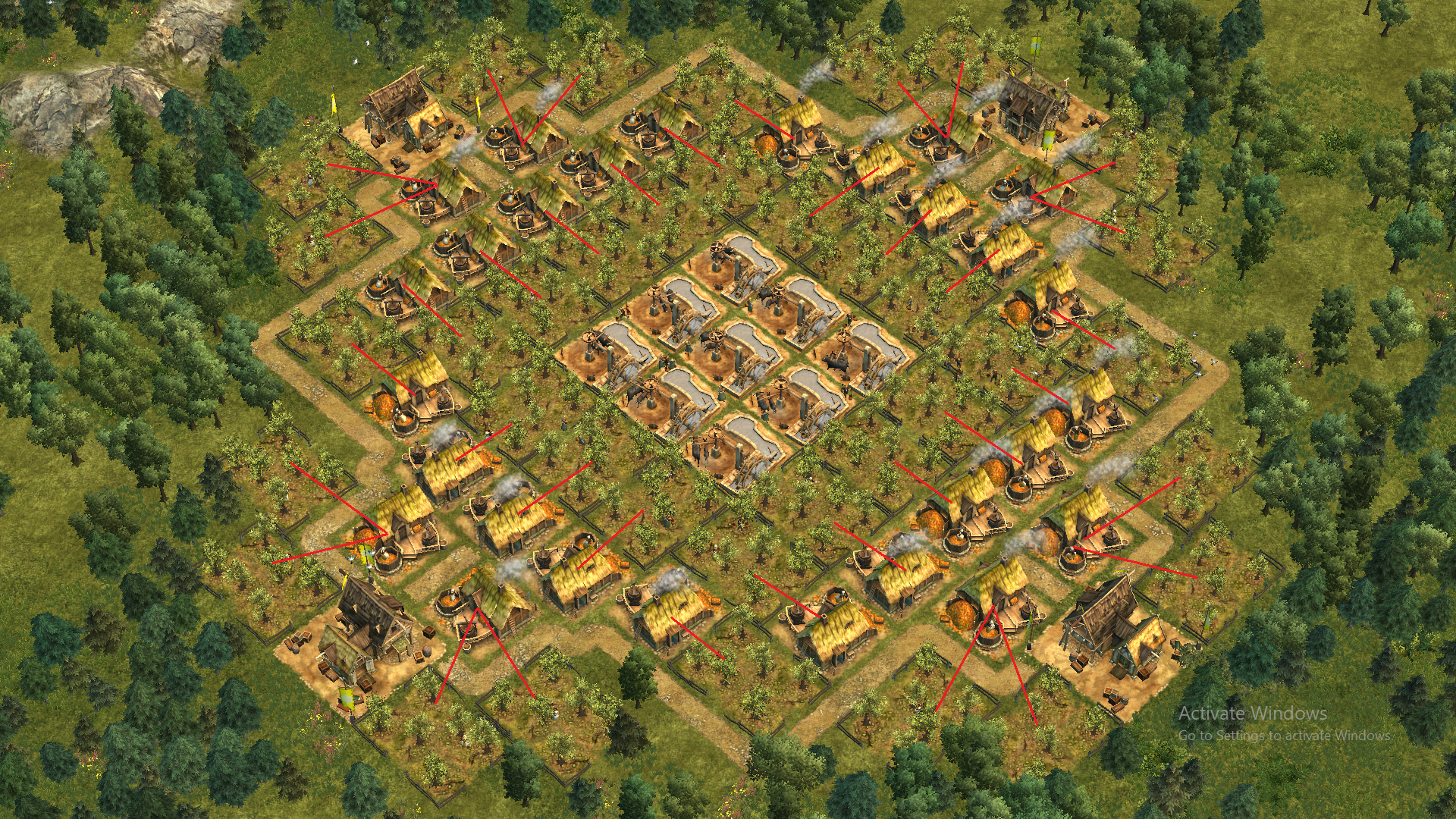 | 28 Hemp or Cider farms all working at 100%. Uses noria exploit. The 8 farms on the outskirts, next to the Market buildings with 1 field work at 92% and they would need to be reached by 1 more noria, 7 being the number to raise 1 field from 25 to 100%. | |||||||||||||||||||||||||
| Large Noria exploit for farms with 5 or 4 fields.
|  | 40×5 field or 4 field farms (Cider, Hemp, Vineyard, Date, Indigo, Silk, Spice, Coffee, Sugar cane) with 100% efficiency. Needs 44×44 tiles with 4 large Norias for Noria exploit to work. Additionally there are 12 3×3 space for any production buildings(Roasting house, Carpet workshop, etc or anything) Note: 2 Market Buildings are not necessary, instead the one on edge can be replaced by 4×4 production building(Clay pit). Full production chains [ edit | edit source ]Creating production chain clusters also has its advantages.
|

